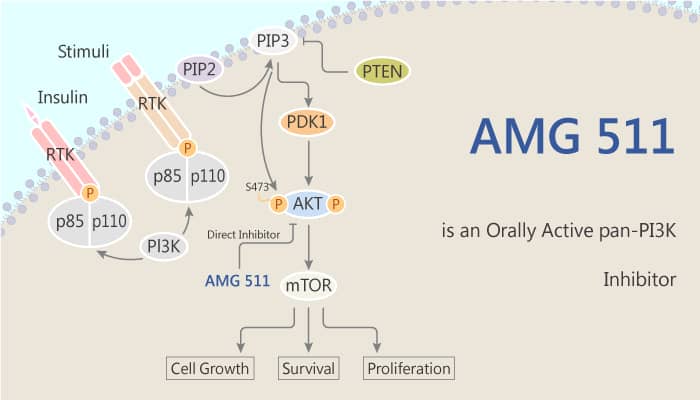The PI3K signaling network has a central role in several cellular processes critical to the initiation and progression of cancer, including growth, survival, and metabolism. The PI3K family catalyzes the phosphorylation of phosphatidylinositol-4,5-diphosphate to phosphatidylinositol-3,4,5-triphosphate, a secondary messenger that plays a critical role in important cellular functions such as metabolism, cell growth, and cell survival.
In this study, researchers describe the design and synthesis of AMG 511. Especially, AMG 511 is a potent pan inhibitor of class I PI3Ks with a superior pharmacokinetic profile. AMG 511 potently blocks the targeted PI3K pathway in a mouse liver pharmacodynamic model and inhibits tumor growth in a U87 malignant glioma glioblastoma xenograft model. In particular, AMG 511 significantly suppresses PI3K signaling. AMG 511 decreases the phosphorylated AKT (p-AKT) at Ser473 in a dose-dependent manner. Inhibition of AKT phosphorylation directly correlates with plasma concentrations (EC50 of 228 ng/mL). However, AMG 511 shows no significant binding affinity toward 372 protein kinases when tested at 1 μM.

AMG 511 is a potent pan inhibitor of class I PI3Ks with a superior pharmacokinetic profile. AMG 511 potently blocks the targeted PI3K pathway in a mouse liver pharmacodynamic model. Furthermore, AMG 511 potently inhibits tumor growth in a U87 MG glioblastoma xenograft model (ED50=0.6 mg/kg). Furthermore, AMG 511 has a superior pharmacokinetic profile with low clearance (0.4 L/h/kg, 12% of liver blood flow). In addition, AMG 511 also has good oral bioavailability (F=60%), and a commensurate high oral exposure (AUC=5.0 μM·h).
Overall, AMG 511, a potent and selective class I PI3K inhibitor and suppresses the growth of Kras mutant lung tumors.